Sony VAIO VGN-TZ11MN Review
Sony VAIO VGN-TZ11MN
Sony has raised the bar again with an ultra-portable notebook to die for!

Verdict
Key Specifications
- Review Price: £1498.99
If you’re a regular reader of TrustedReviews you’ll know that I’ve been a fan of Sony’s TX series notebooks for some time. The VAIO TX3XP coupled amazing battery life with a great screen and feather-light weight, but there was one aspect of that ultra-portable machine that annoyed me – it didn’t have a dual-core CPU. You see in order to achieve the great battery life, Sony opted for Intel’s Ultra Low Voltage CPU, which only came in a single-core package, but that was then and this is now…
With Intel’s recent update to its notebook platform, it finally decided that the Ultra Low Voltage mobile chip deserved to be a dual-core affair. So now you can get a dual-core, mobile Core 2 Duo chip running at 1.06GHz on each core, and that’s exactly what Sony has used to drive its new VAIO TZ Series notebooks.
It doesn’t take a genius to realise that the TZ Series is the natural successor to the TX VAIOs, but it’s clear that Sony was waiting for this new chip to arrive before changing the letter designation. That said, the TZ Series is far more than just a processor bump over the TX, it’s a completely different machine, with new chassis and (although this is hard to believe) an even more sleek and stylish design.
There are a few variations on the TZ1 notebook, with prices ranging from £1,399 all the way up to £2,099. The Sand coloured VAIO VGN-TZ11MN that I’ve got in front of me right now sits in the middle of the price range at £1,498.99 and probably represents the best option for the vast majority of potential buyers. What’s particularly impressive is that historically the TX Series machines carried far higher entry level price points at launch, so perhaps Sony is trying to open its ultra-portable range up to a wider audience.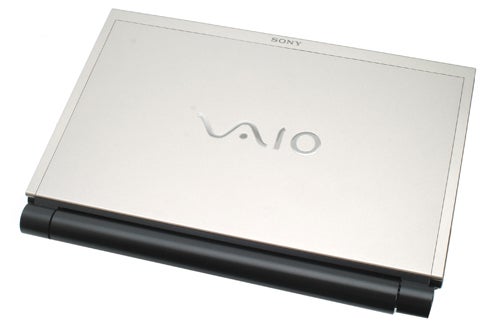
There’s no getting away from the fact that design plays a big part when it comes to ultra-portable notebook computers, and there are few manufacturers out there who can do a better job in this department than Sony. It’s interesting that I’ve read a few news reports around the Web stating that Sony has copied the Apple MacBook when it comes to the keyboard design of the TZ1. Unfortunately for all the Apple fans out there, this is simply not true. In fact, Sony implemented this type of separated-button style keyboard in the groundbreaking VAIO X505VP back in 2004. It worked well then and it works well now – clearly something that Apple realised when it was designing the MacBook.
Like the keyboard on X505VP, the keyboard on the TZ is surprisingly good, despite its unconventional design. The keys are all well separated and spaced, and there’s a discernable amount of travel when striking each key. I had no problem sitting down at the TZ11MN and typing at full pelt, but then I do have pretty small hands. That said, I think that someone with particularly big hands probably won’t be looking at a notebook this small in the first place, regardless of keyboard design. 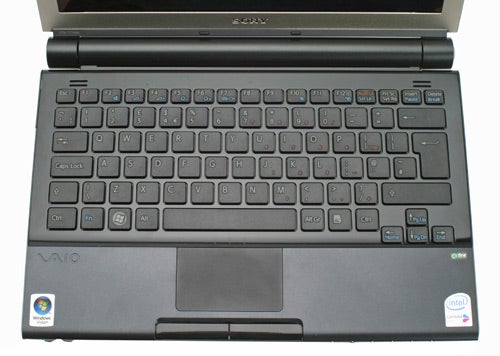
The keys are finished in matt black, which allows for a stunning contrast with the glossy casing surrounding the keys. Sony has also ensured that the Ctrl key is in the bottom left corner where it belongs instead of putting the Fn key there as notebook manufacturers often do. The correct placement of the Ctrl key is paramount for anyone who relies on keyboard shortcuts regularly. The rest of the keyboard layout is also spot on, with the Tab, Shift, Return and Backspace keys all large for easy access. Despite the svelte dimensions, the cursor keys are also dropped away from the main keyboard making them easy to find and use.
Below the Spacebar is a touchpad with a widescreen aspect ratio to match the display. The touchpad has a nice tactile feel to it, while its very responsive nature makes pointer manipulation a breeze. You can also use the right side of the touchpad to scroll through web pages and documents, while the bottom edge also allows horizontal scrolling. Two large, black glossy buttons sit below the touchpad, contrasting well with the matt black wrist rest, and exhibiting a reassuring click when pressed.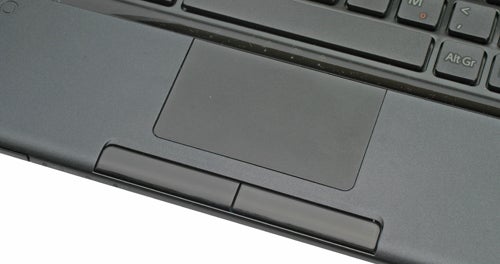
Like the TX Series notebooks, the lid on the TZ is incredibly thin. The metallic Sand finish on the lid also looks superb, especially with the mirror-silver VAIO logo in the middle. The reason that the lid is so amazingly thin is that the embedded screen uses LED backlight technology, rather than the more traditional cold cathode light source. Early versions of the TX Series exhibited light bleed issues from the LED backlight, but the screens became consistently better as each new version of the TX launched. It’s that ongoing LED screen development that no doubt paved the way for the screen in the TZ11MN, which is quite possibly the best display I’ve ever seen in a notebook computer.
There are several advantages to using an LED backlight screen. I’ve already mentioned that it makes for a very thin lid, but it also increases battery life significantly. The other big plus for an LED backlight LCD screen, is that it gives you a far wider colour gamut than a traditional LCD, which is why NEC’s mega-high-end SpectraView Referance 21 monitor uses similar technology. Although the wide colour gamut isn’t as important on an 11.1in notebook screen, there is no denying that the colours on this display look better than on any other notebook I’ve reviewed. In fact not a single member of the TR team failed to comment on just how great this screen looks!
Despite its small dimensions, the screen in the TZ11MN sports a native resolution of 1,366 x 768, which is a true 16:9 aspect ratio, as seen in most HDTVs. The display also sports a high contrast glossy coating, but unlike many screens using this type of coating, the viewing angle is incredibly good, so you and the person next to you could, say, watch a movie during a long train journey – although you’d probably also need two sets of headphones and a headphone jack splitter.
Above the screen is a built-in 0.3-megapixel webcam, making the TZ11MN perfect for the odd bid of video Skype chatting. Sony even preloads Skype onto the notebook to get video over IP streaming straight off the bat. This is definitely a webcam, rather than a camera for taking stills, as seen on the old VAIO TR2MP, since it’s a fixed device. This is no bad thing though, since I never really saw the point in installing a digital still camera in a notebook, no matter how small it is.
In a hark back to the VAIO X505VP, Sony has mounted the power button in the right hinge of the lid – I thought this looked cool on the X505VP and it looks just as good on the TZ11MN. It’s good to see that the button glows a pale green when the notebook is switched on, rather than the somewhat ubiquitous blue. The power socket is located in the left lid hinge to add a degree of continuity. Also like the X505VP, the battery slides in between the hinge points, creating a barrel effect running along the back of the machine.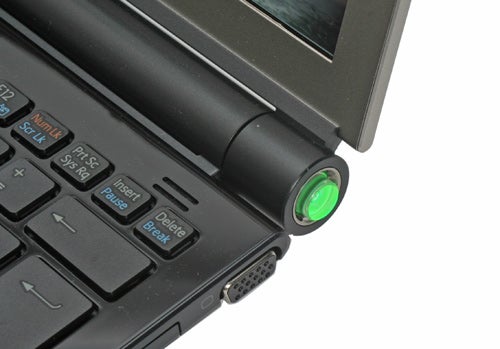
The TZ11MN is ever so slightly larger than the TX Series that it replaces, but only by a few millimetres. With dimensions of 276 x 199 x 29mm (WxDxH) this is a very slim machine. Sony quotes a weight of 1.19kg, and that’s exactly what the TZ11MN registered on the TrustedReviews scales, so it’s actually a tad lighter than the outgoing TX Series.
Despite the svelte dimensions and the very light weight, Sony has still managed to squeeze an optical drive into the TZ11MN. On the right side of the chassis is a dual layer DVD writer which will accept DVD+R/RW, DVD-R/RW and even DVD-RAM. The DVD drive also highlights the fact that this machine can playback both DVDs and CDs without actually booting into Windows. The AV mode boots pretty much instantly and lets you view images or listen to music files as well as play optical media. Next to the DVD writer on the right is a D-SUB port for connecting to an external monitor, but considering the screen on this notebook, I have no idea why you’d want to do that.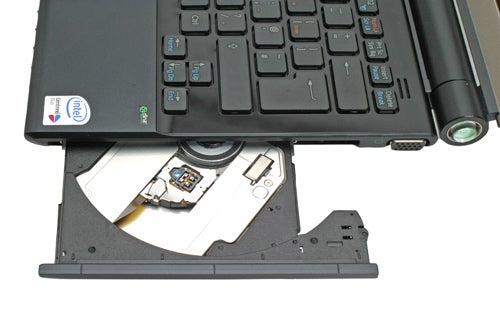
Unusually, the front is jam packed full of features. First up there’s the full set of AV buttons – Play/Pause, Stop, Skip Back, Skip Forward and Eject, along with the AV Mode button itself. Below the AV buttons is a hardware switch for the wireless adapters, complete with status indicators. Also at the front are memory card readers for both SD/MMC and MemoryStick formats, along with both headphone and microphone sockets.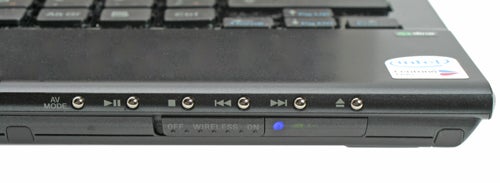
On the left are two USB 2.0 ports, which are conveniently next to each other – ideal if you want to power an external hard disk that requires juice from more than one port. Also on the left side of the chassis is a flap which hides a modem socket, an Ethernet port and a four-pin FireWire port. Finally you’ll find a spring loaded flap that hides an Express Card slot – testament that it’s time I got myself either an Express Card or USB based HSDPA modem!
As already mentioned, there’s a brand new Intel Ultra Low Voltage Core 2 Duo CPU running at 1.06GHz inside the TZ11MN. Never before has a notebook this thin and light been equipped with a dual-core CPU, so anyone who has been put off the TX Series due to its single-core nature should be very happy indeed. However, unlike the rest of the new Core 2 Duo range, the ULV part doesn’t run with an 800MHz bus, instead employing a more conservative 533MHz FSB. As a result the TZ11MN isn’t using Intel’s new Mobile 965 Express chipset, instead using the older 945 chipset. This means that the TZ11MN goes part way down the Santa Rosa road, but it’s not compliant to the new platform in the true sense. That said, it would appear that the vast majority of the new features that appeared with the Santa Rosa platform aren’t actually mandatory anyway.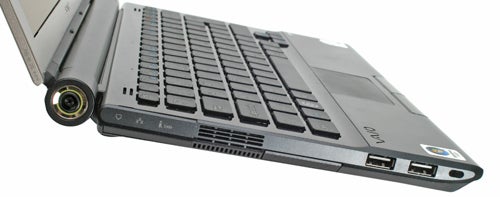
Supporting the new CPU is 1GB of RAM, which is an absolute minimum in these Vista days. The TZ11MN will support up to 2GB of memory and my advice would be to upgrade at the point of purchase, because Vista is seriously memory hungry, so the more you have, the better. There’s an 80GB hard drive, which seems very capacious for a machine of this size, although the higher-end models feature 100GB drives, while the entry level spec makes do with a 60GB version.
If you’ve got £2,099 burning a hole in your pocket, you can buy a version of the TZ1 with a 32GB solid state hard disk inside, for lightning fast access times, better battery life and no disk fragmentation issues. I’ll be trying to get hold of the SSD version soon and see how it compares to this machine. Personally, I’d rather have an SSD in my notebook, thus eliminating a mechanical point of failure, even if it means lower capacity. After all, how much data do you really need on your ultra-portable notebook?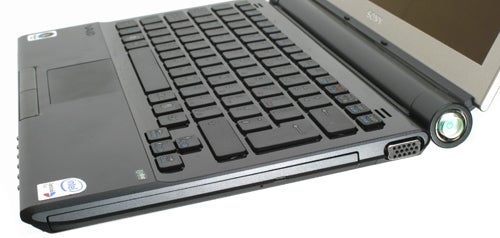
Connectivity is more impressive than most desktop replacement machines, with an Intel PRO/Wireless 3945ABG Wi-Fi adapter, which supports 802.11a, b and g standards. There’s also integrated Bluetooth for connection to a mobile phone, equipped digital camera or a headset. Sony hasn’t skimped on the wired connectivity either with a Gigabit Ethernet adapter as well as the obligatory 56k modem.
Put simply, the TZ11MN is an absolute joy to use. Words just can’t describe how rich and vibrant colours look on this screen – I’ve never seen Vista look quite this good before, while a viewing of Apocalypse Now revealed a staggering amount of detail to the lush jungle scenes that I’d forgotten was there. It may only be utilising the integrated Intel graphics chipset, but it still has no problems making the most of Vista’s snazzy Aero desktop.
At times the TZ11MN can feel a little sluggish under Vista, but this is down to the amount of system memory at its disposal. Feeding it a healthy 2GB serving of RAM when you put your money down should solve that problem quick smart.
It’s important to remember though, that this notebook is not about raw performance, it’s about being a fully featured, mobile computer that’s thin and light enough to be carried anywhere and everywhere. In single-core applications, the TZ11MN performed much like the Asus U1F, which sported a dual core 1.06GHz CPU, but not in ULV guise. However, the TZ11MN will obviously provide better battery live, while still running multi-threaded applications, or multi-tasking. 
Sony is quoting nine hours battery life for the TZ11MN, which is the same as the TX3XP. I ran MobileMark on the TX3XP and it actually lived up to its nine hour billing, but since BaPCo still hasn’t produced a Vista version of MobileMark, I couldn’t do the same on this machine. Instead I implemented some subjective battery testing – I turned off the screen saver, stopped the screen from turning off and used the TZ11MN all day. I have been writing this review on the machine, doing various amounts of web browsing over both wired and wireless connections and played back some DVD content etc. The result was a battery life of around six hours, but it’s fair to say that this would be significantly higher if I allowed the machine to implement various power saving features, like switching off the screen in periods of inactivity, dropping the CPU performance and switching the wireless adapters off when not in use.
It’s therefore fair to say that the TZ11MN is the perfect partner for anyone who needs to work away from a power socket all day. It’s also very impressive that the dual-core CPU hasn’t detrimentally affected battery life to a significant extent.
Continuing my tradition of automotive analogies, the TZ11MN is like the notebook equivalent of a Pagani Zonda – it’s sleek, stylish, beautiful to look at and has a chassis lovingly crafted from carbon fibre. Luckily you don’t have to be a multi-millionaire to own a TZ11MN though…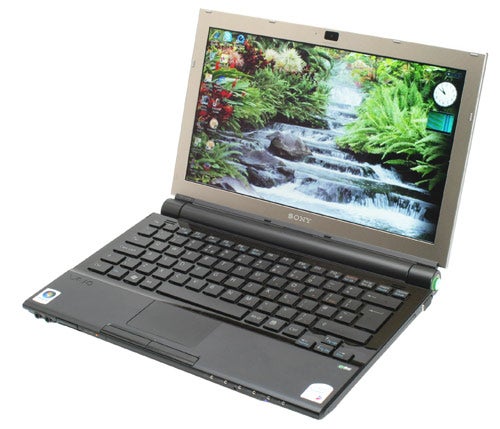
”’Verdict”’
Sony has built on the good points of the TX Series but also taken some inspiration from the iconic X505VP and produced a truly stunning ultra-portable notebook. Sony has mastered the LED backlight technology and created the best notebook screen I’ve ever seen, while Intel’s new dual-core ULV mobile chip is also a triumph for the ultra-portable notebook platform. It could do with more memory, but other than that Sony has pretty much hit the target in every area.
The price is high, but you’re getting a lot of cutting edge technology for that price, and it’s worth remembering that the starting price for the TZ Series is significantly lower than it was for any of the TX Series products at launch. Ultimately, if I could have any notebook computer on the market right now, it would be this one – enough said!
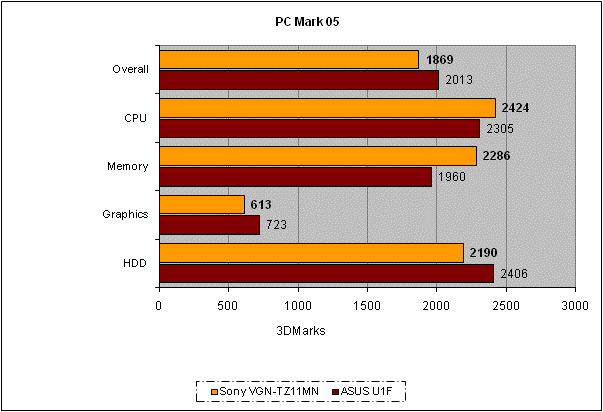
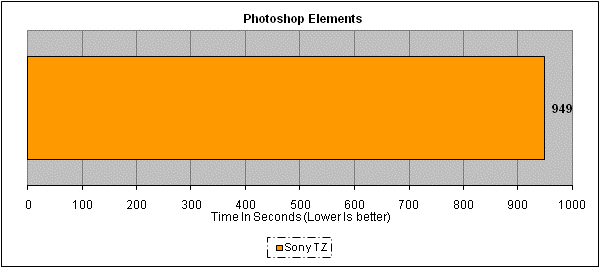
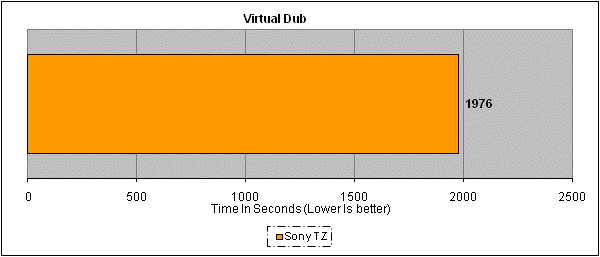
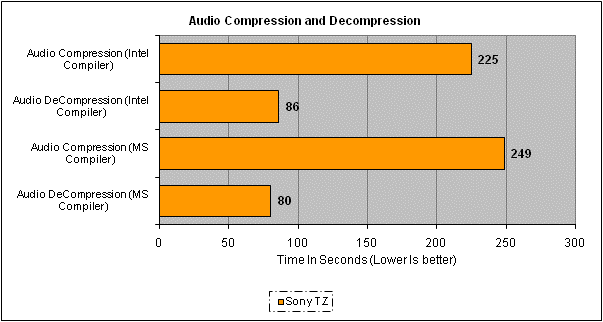
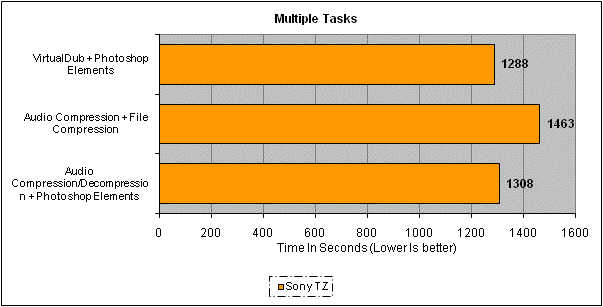
How we test laptops
Unlike other sites, we test every laptop we review thoroughly over an extended period of time. We use industry standard tests to compare features properly. We’ll always tell you what we find. We never, ever, accept money to review a product.
Trusted Score
Score in detail
-
Performance 8
-
Value 9
-
Features 10

